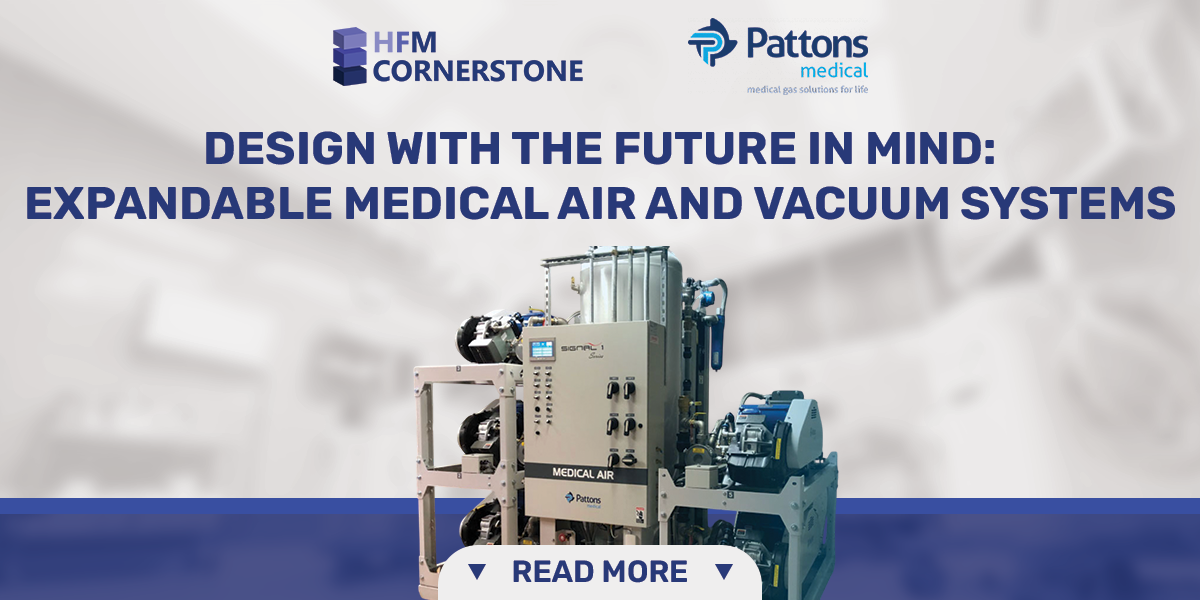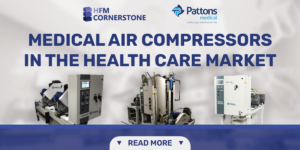Hospitals and healthcare facilities are evolving faster than ever. With growing patient populations, the rapid introduction of new medical technologies, and the ever-present possibility of emergencies, engineers must plan for more than just today’s demands.
The lesson from recent years is clear: future-proofing medical gas and vacuum systems is essential.
Anticipating Growth Before It Happens
From facility expansions to unforeseen surges in patient needs, healthcare environments demand systems that can adapt quickly. The COVID-19 pandemic forced hospitals to dramatically increase their ventilator capacity almost overnight. In rapidly growing regions, population spikes have placed unprecedented pressure on ICUs, surgical suites, and patient wings—along with the infrastructure that supports them.

“Expandable systems protect hospitals from the unknown — whether it’s a pandemic, a new technology, or a surge in patient load,” said Greg Hood, Vice President at Pattons Medical. “Designing to minimum demand isn’t enough anymore. Facilities need flexibility built in from day one.”
Why Expandability Matters
Medical gas and vacuum systems must evolve alongside the facilities they support. Whether it’s adding a new ICU or preparing for the next generation of external catheters and ventilators—equipment that demands high SCFM—today’s infrastructure must be designed to grow.
When consultants are brought in early, they work with engineers to build flexibility into every stage of the design. This includes systems that can accommodate future:
Compressors and vacuum pumps
Control panels and alarms
Distribution piping upgrades
Electrical infrastructure expansions
Increased equipment load and redundancy
“One of the first things we ask when we meet with engineers is what’s on the horizon—new towers, wings, or specialty units, even if they’re three to five years away,” Hood explained. “That way, we help them design a system that grows with the facility, not one that needs to be ripped out and rebuilt.”
The High Cost of Inflexibility
Failing to account for future needs can be expensive and disruptive. Retrofitting a medical gas system is not only costly—it can also lead to temporary service interruptions, potential code violations, and compromised patient safety.
Common consequences of under-planning include:
Total system overhauls
Physical demolition and wall removal
Missed opportunities for energy-efficient upgrades
Ineligibility for sustainability grants and rebates
Overstressed equipment and frequent breakdowns
“We’ve walked into hospitals stuck with undersized systems because no one planned for growth,” Hood said. “By the time they’re ready to expand, they’re tearing down walls and missing out on energy efficiency incentives they could’ve secured from the start.”
Smart Design is Strategic Design
Expandable systems aren’t just about adding extra pumps or piping. They’re the product of thoughtful, forward-looking design.
Medical gas consultants guide engineers through critical questions, such as:
Are there planned facility expansions in the next 3–5 years?
What’s the expected demand during an emergency scenario?
Is there space for future compressors, alarms, or control panels?
Is the current electrical infrastructure capable of supporting growth?
Are there code or regulatory changes on the horizon?
Has the facility explored rebates or ESG-linked funding opportunities?
“Expandable design isn’t just about hardware — it’s about strategy,” Hood added. “We help engineers think ahead and make decisions that will hold up for the long term.”
Making Expandability the Standard
Designing systems to the minimum expected demand is an outdated practice. Expandable system design has become the new standard—one that accounts for:
Emergency preparedness
Technological advances
Sustainability goals
Financial efficiency
Patient safety and care continuity
When expandability becomes a core design principle, hospitals are better positioned for whatever comes next—whether it’s a sudden crisis, rapid growth, or the next generation of life-saving medical equipment.
“If you’re not thinking about expansion today, you’re planning for disruption tomorrow,” Hood said. “Working with an experienced medical gas consultant ensures better outcomes for engineers, facilities—and most importantly—patients.”




